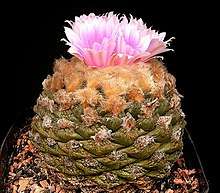Ariocarpus fissuratus
Ariocarpus fissuratus (formerly known as Anhalonium fissuratus) is a species of cactus found in small numbers in northern Mexico and Texas in the United States. Common names include living rock cactus, false peyote, chautle,[2] dry whiskey and star cactus.[3]
| Ariocarpus fissuratus | |
|---|---|
 | |
| Scientific classification | |
| Kingdom: | Plantae |
| Clade: | Tracheophytes |
| Clade: | Angiosperms |
| Clade: | Eudicots |
| Order: | Caryophyllales |
| Family: | Cactaceae |
| Subfamily: | Cactoideae |
| Genus: | Ariocarpus |
| Species: | A. fissuratus |
| Binomial name | |
| Ariocarpus fissuratus (Engelm.) K.Schum.[2] | |
| Synonyms[2] | |
|
Mammillaria fissurata Engelm. | |
Description
This cactus consists of many small tubercles growing from a large tap root. They are usually solitary, rarely giving rise to side shoots from old areoles. The plant is greyish-green in color, sometimes taking on a yellowish tint with age.[4] Its growth rate is extremely slow. A. fissuratus is naturally camouflaged in its habitat, making it difficult to spot.[3] When they are found, it is usually due to their pinkish flowers which bloom in October and early November.[3]
Cultivation
In cultivation, Ariocarpus fissuratus is often grafted to a faster-growing columnar cactus to speed growth, as they would generally take at least a decade to reach maturity on their own. They require very little water and fertilizer, a good amount of light, and a loose sandy soil with good drainage.
Poaching
Tens of thousands of this protected Texas cacti are annually removed Illegally. [5] Poaching has even extended to Big Bend National Park. Smugglers have taken entire populations of A. fissuratus, primarily for collectors, mainly in Europe and Asia. Loss of such a wide range of genetic variation weakens the species chances of future survival.[6] According to the U.S. Department of Justice, the cactus is protected by the Convention on International Trade in Endangered Species of Wild Fauna and Flora (CITES).[7]
Psychoactivity
Ariocarpus fissuratus is a unique species in that it has been used by Native American tribes as a mind-altering substance, usually only as a substitute for peyote.[8] While it does not contain mescaline like many other North American cactus species (such as peyote), it has been found to contain other centrally active substances, such as N-methyltyramine and hordenine,[8] albeit in doses too small to be active.
Notes
- Fitz Maurice, B.; Sotomayor, M.; Terry, M.; Heil, K.; Fitz Maurice, W.A.; Hernández, H.M. & Corral-Díaz, R. (2017). "Ariocarpus fissuratus". The IUCN Red List of Threatened Species. IUCN. 208. e.T152093A121435805. doi:10.2305/IUCN.UK.2017-3.RLTS.T152093A121435805.en.
- "Ariocarpus fissuratus". Germplasm Resources Information Network (GRIN). Agricultural Research Service (ARS), United States Department of Agriculture (USDA). Retrieved 2010-10-02.
- Morey, Roy (2008). Little Big Bend : Common, Uncommon, and Rare Plants of Big Bend National Park. Lubbock: Texas Tech University Press. p. 43. ISBN 9780896726130. OCLC 80359503.
- Description Reference
- Walker, R, “Texas’s cactus cops battle to save rare desert beauty from smuggling gangs” https://www.theguardian.com/environment/2020/jun/20/agents-save-rare-cactus-texas-smuggler], The Guardian , 20 June 2020. Retrieved 21 June 2020.
- Barrus, A. “Special Agents and Partners Strike Major Blow to Cactus Black Market” https://www.fws.gov/southwest/stories/2019/Rockcactus.html], U.S. Fish and Wildlife Service , 2019. Retrieved 21 June 2020.
- U.S. Attorney’s Office [" El Paso Man Pleads Guilty to Role in Scheme to Sell Protected Cacti" https://www.justice.gov/usao-wdtx/pr/el-paso-man-pleads-guilty-role-scheme-sell-protected-cacti], ' Department of Justice , June 2020. Retrieved 21 June 2020.
- Ratsch, C: "The Sun", page 67. Park Street Press, 2005
References
Ratsch, C. (2005). The Encyclopedia of Psychoactive Plants: Ethnopharmocology and its Applications, Vermont: Park Street Press. ISBN 0-89281-978-2
External links
| Wikispecies has information related to Ariocarpus fissuratus |
| Wikimedia Commons has media related to Ariocarpus fissuratus. |
